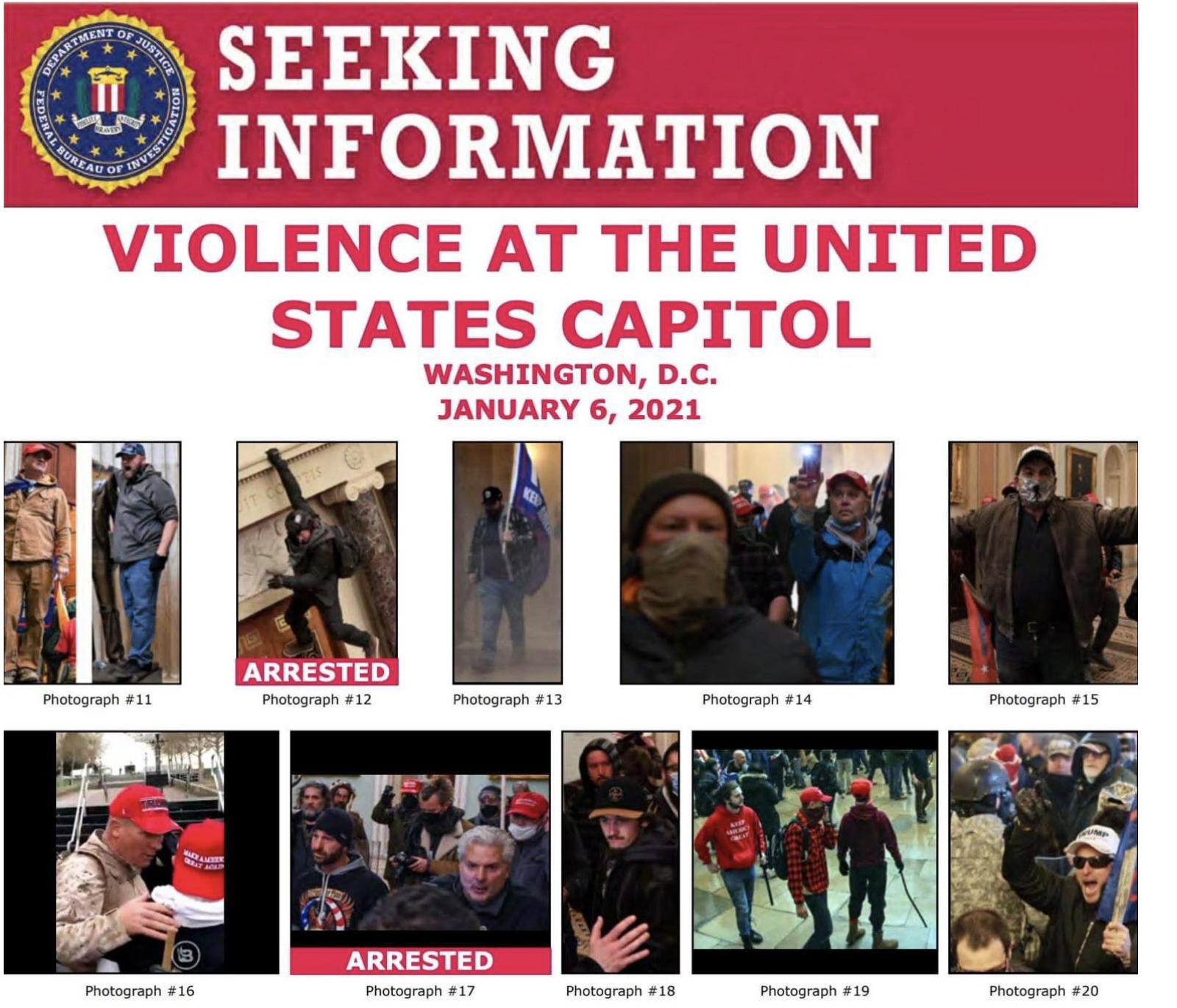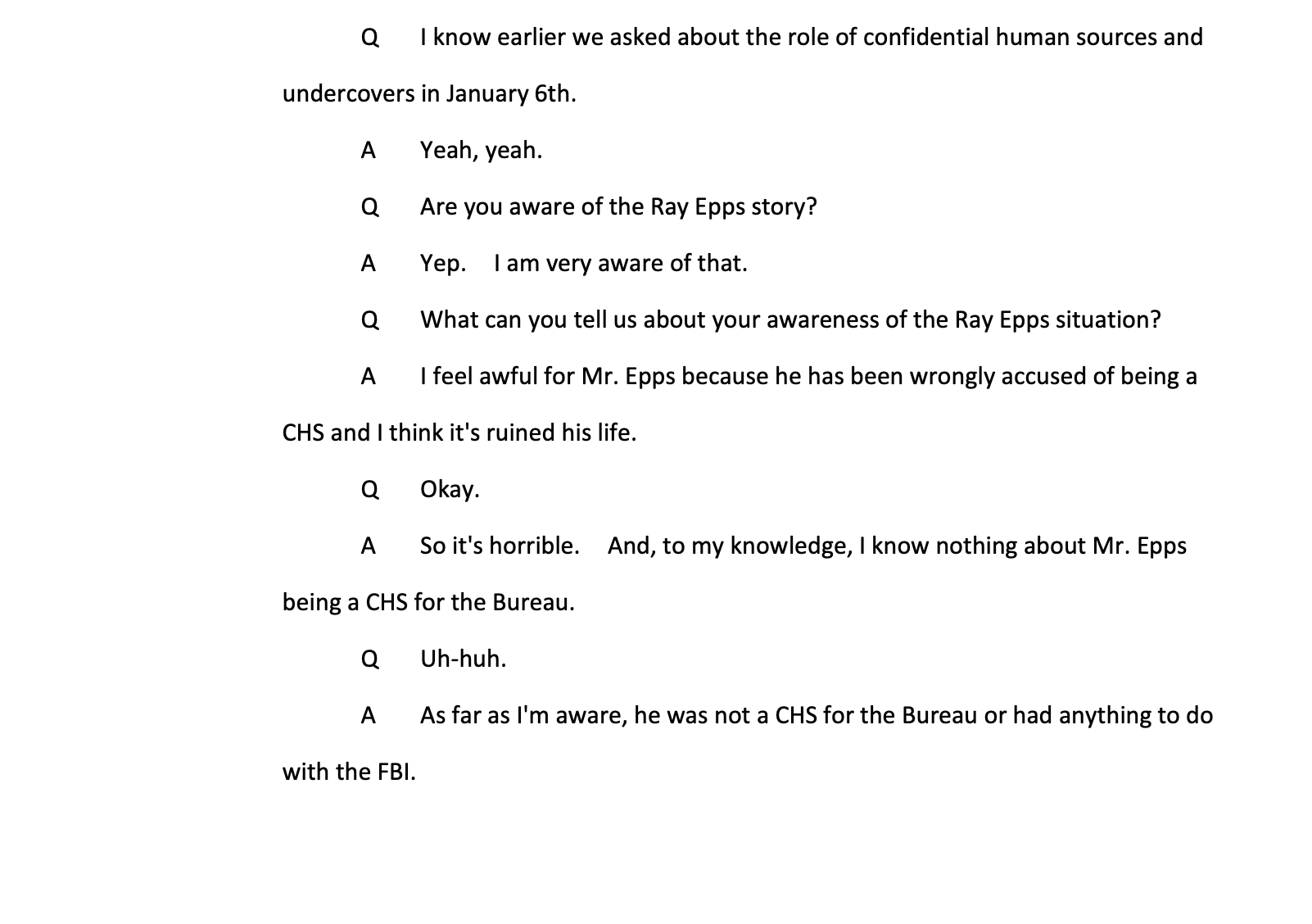Support Revolver at this critical time for independent journalism. Click here to get an ad-free subscription. Or, join the fight by giving a one-time or recurring donation.
Yesterday, infamous “Fedsurrection” figure Ray Epps pled guilty to a one-count misdemeanor charge of “disorderly conduct in a restricted area” for his role in the events that took place at the Capitol on January 6, 2021. Under the terms of the plea agreement, Ray Epps will most likely be spared prison time (he will face between zero and six months in prison) and have to pay $500 in restitution.
The bizarre plea agreement came just one day after Epps was charged via a highly-media-trumpeted “information” (not indictment).
This lame single charge tells us everything we need to know about Ray Epps.
No obstruction felony? No civil disorder charge? Not even a trespassing on restricted grounds misdemeanor?
Can't even tell you the last time I saw an "information" (misdemeanor version of indictment)… pic.twitter.com/zQ0rGT23ES
— Julie Kelly 🇺🇸 (@julie_kelly2) September 19, 2023
In Ray Epps’ legal complaint suing Fox News for Tucker Carlson’s amplification of Revolver News’ ground-breaking reporting on Ray Epps, Epps telegraphed that he expected to be charged at some point by the DOJ (emphasis ours):
Finally, in May 2023, the Department of Justice notified Epps that it would seek to charge him criminally for events on January 6, 2021 two-and-a-half years later. The relentless attacks by Fox and Mr. Carlson and the resulting political pressure likely resulted in the criminal charges. Although it is difficult to believe that the Department of Justice would have pursued this matter if Fox had not focused its lies on Epps, ultimately the criminal charges conclusively demonstrate the falsehood of the story that Mr. Carlson and Fox told about Epps.
There is a lot to digest here, but first of all, it’s worth noting that the DOJ did Ray Epps the remarkable courtesy of letting him know in advance that he was going to be charged. As far as we are able to determine, Ray Epps was not subject to any sort of arrest, midnight raid, SWAT treatment, broken down doors, or anything so much as even a proper search. This is yet another marked contrast to the treatment visited upon fellow January 6th participants, many of whose participation was far less egregious than that of Epps.
Unlike so many other January 6th participants charged with an obstruction of an official proceeding felony, Epps has managed to get away with a seemingly perfunctory slap on the wrist misdemeanor charge. This discrepancy can furthermore be hardly explained by the fact that Epps didn’t go into the Capitol. Thomas Caldwell, to pick just one of many examples, was charged with Obstruction of an Official Proceeding, Conspiracy, and Seditious Conspiracy among other charges. Caldwell did nothing violent and did not go into the Capitol.
Enrique Tarrio, the Proud Boys leader who whose 22 year sentence is the most severe of all January 6th cases, also did nothing violent and did not go into the Capitol. In fact, Tarrio was not even in D.C. during the events of the 6th.
The reason Tarrio was convicted of a seditious conspiracy and sentenced so harshly is that the government maintained, without much evidence whatsoever, that Tarrio played a key role in orchestrating the events of January 6th.
Ironically, unlike Proud Boy leader Tarrio, Ray Epps, who was the former head of the Arizona chapter of the Oath Keepers militia group, texted to his nephew of his role in the events of January 6th, “I was in the front with a few others. I orchestrated it.”
According to Epps’ own statements his role in January 6 was that of an orchestrator, which pretty fairly corresponds to the video documentation of his behavior on both January 5th and January 6th.
BREAKING: Ray Epps sues Fox News for defamation for reporting on the suspicious behavior of Ray Epps (below)
The only J6 participant the DOJ, NYT, 60 Minutes, and Adam Kinzinger will bend over backward to defend. https://t.co/cc6yyjyYsH
— Darren J. Beattie 🌐 (@DarrenJBeattie) July 12, 2023
In what shouldn’t be surprising given the footage above, Ray Epps’ behavior was so egregious that it caught the early attention of the FBI, who immediately put his picture as one of the first top 20 on their January 6th most wanted list.
In what is now infamous history, the Feds kept Epps’ picture up on the most wanted list only until Revolver News began publishing its bombshell pieces exploring the possibility of Federal involvement in January 6th. Our first such piece exploring federal involvement in January 6 appeared on June 14, 2021. After making a splash with this groundbreaking piece, our next major piece developing the same theme appeared June 30, 2021. The very next day, the FBI quietly and curiously removed Ray Epps from its most wanted list, without any explanation whatsoever.
Then, on July 1, between the hours of 3:37 a.m. and 5:55 p.m., the FBI finally took action on Ray Epps. But not to prosecute him, or to announce a sweeping investigation or FBI SWAT raid on Epps’s house for all of his phones and electronics. Instead, someone at the FBI quietly and stealthily purged every trace of Ray Epps from the Capitol Riots Most Wanted database.
Using the Wayback Machine from archive.org, we see that from January 8, 2021 until 3:37 a.m. on July 1, every archived version of the FBI.gov website shows Ray Epps as Suspect 16. The below photo is just a snapshot sample from February 16, 2021 — but users can view the Web Archive themselves to witness the Ray Epps purge occurring sometime between 3:37 a.m. and 5:55 p.m. on July 1. That would be during the FBI workday.
The above is enough to rule out the notion that somehow the DOJ decided to charge Epps because it just became aware of Epps and his behavior. Quite the contrary: Epps’ behavior was considered so egregious by the FBI that they included him as one of their top 20 most wanted as early as January 8, 2021. The suspicious timing of the FBI removing Epps’ picture furthermore suggests that the Feds are very sensitive and in some cases responsive to publicity regarding Epps.
If there is no obvious, innocent explanation for the Feds waiting so long to charge Epps with something, what about the nature of the charge itself? Does a misdemeanor “disorderly conduct” charge comport at all with the standards of prosecution applied to others? As noted above, it makes very little sense that Epps wouldn’t have been charged with the felony “obstruction of an official proceeding,” as have so many other high profile (and not so high profile) January 6th defendants.
A simple trespassing charge would have been a layup indictment available to the DOJ from day 1, and yet for some reason they passed on it. Though trespassing is a misdemeanor charge, the DOJ can still use it to ruin someone’s life if they feel motivated to do so. If anyone doubts this, see Revolver News’ coverage of the outrageous treatment of former Green Beret Jeremy Brown. In Brown’s case, the DOJ used the misdemeanor charge as a pretext to raid Brown’s house, where they claimed they found illegal firearms that served as the basis for additional felony charges.
In late September of 2021, approximately 20 FBI vehicles swooped in on Brown’s home, searched his belongings for over five hours, and took all of his phones and electronics before arresting him. What grave January 6 offense could have possibly justified such a dramatic action on the part of federal authorities? After all of the fanfare, Brown was arrested and charged with trespassing on restricted grounds and disorderly conduct—both misdemeanors.
It is worth repeating that the full SWAT treatment (five-hour long search, seizure of electronics, et cetera) is not atypical for January 6th defendants. The above-mentioned Thomas Caldwell also received such SWAT treatment. What was atypical in Jeremy Brown’s case was that the DOJ waited so long to charge him. Indeed, a quick glance at the excerpt above reminds us that the DOJ sat on top of the misdemeanor charge for nearly a year.
Why, then, did the Department of Justice wait nine months after January 6 to raid Jeremy Brown’s home and arrest him for a misdemeanor trespassing charge? Typically new charges would emerge from new evidence, but in this case we know that the Feds were aware of Jeremy’s presence in the “restricted zone” as early as January 6th. Per the FBI’s affidavit, the FBI even called Brown directly, both on January 6 and again on January 7. Brown plainly told them where he was. The FBI even served a search warrant on Verizon, on January 6 itself, which identified Brown’s cell phone coordinates as being inside the Capitol restricted grounds.
What was the change in circumstances? In the case of Brown, it was the fact that in the intervening time he had gone public with video exposing JTTF agents trying to recruit him as an informant for something big happening in early January — this not only exposed the fact that the government had an aggressive recruitment program in place, but they themselves were anticipating something big in early January. In retaliation for exposing them, the government decided it had to make an example of Brown. It was at that point that the DOJ decided to charge Brown with a petty misdemeanor and sent twenty FBI agents to raid his home and search his things, leading to the bogus felony charges for which he has been sentenced to over seven years in prison.
We don’t want to rehash too much of the case of Jeremy Brown. For those with the stomach for all the sordid details, we recommend reading our full piece. The parallels and contrasts between Brown’s case and Epps’ case are nonetheless instructive. The DOJ was aware of both Epps and Brown very early on, just days after January 6th. And yet, in both cases the DOJ waited a considerable amount of time to indict with a mere misdemeanor — in Brown’s case the DOJ waited approximately 8 months. In Epps’ case the DOJ waited an astonishing 2 years and 8 months to issue an indictment. In Brown’s case, it was a matter entirely unrelated to the misdemeanor charge that motivated the DOJ to prosecute him — namely, the fact that he publicly exposed an attempt to recruit him as an informant leading up to January 6th. After that point, the DOJ had to make an example out of Brown.
But one would think the DOJ would have been interested in making an example of Epps, albeit for different reasons. In a telling interview with 60 Minutes, then Acting U.S. Attorney for D.C. Mike Sherwin noted two relevant details regarding his prosecution strategy for January 6 related crimes. First, he infamously announced a “shock and awe” campaign to arrest and charge as many people as possible before Joe Biden’s Inauguration. Second, he noted a special priority to indict so-called “internet stars,” that is, those whose behavior was so egregious as to become viral, circulate on the internet, and make a mockery of the DOJ. See minute 4:00 of the below video:
This acknowledgement on Sherwin’s part made it all the more curious that Epps remained untouched by the DOJ for two years and eight months. Epps was not only on the most wanted list as early as January 8th, his behavior on January 5th and 6th was the very stuff of which virality is made. Epps’ behavior was so egregious that of all of the footage the New York Times could have chosen for its ominously titled “Day of Rage” documentary on January 6th, it chose to feature Epps twice.
Again the NYT video documentary features Epps as one of the key orchestrators of the Capitol siege pic.twitter.com/yT5qt9trBl
— Darren J. Beattie 🌐 (@DarrenJBeattie) July 14, 2022
Apart from these factors, Epps would seem on paper at least to be the very kind of figure the DOJ might want to make the poster boy for the “insurrection” it was trying to build up in the public’s imagination. After all, here was a large man in camo clothing and a Trump hat very publicly and prominently exhorting crowds to go “into the Capitol.” Furthermore, Epps had previously been the leader of the Arizona chapter of the Oath Keepers, the most demonized and heavily prosecuted militia group related to January 6th. And yet not only was Epps left untouched, after speculation circulated as to whether Epps was working for the federal government in some capacity he became the only January 6 participant that the regime media would defend.
The New York Times, which as mentioned had previously featured Epps as someone who planned the January 6th riot in advance, abruptly changed its tune. The Times in fact did a fully dedicated puff piece on Epps, chronicling how difficult his life had become after pesky journalists like Revolver News and Tucker Carlson dared to ask basic glaring questions regarding his involvement in January 6th. 60 Minutes did a sympathy segment on Epps without so much as giving the other side (namely, that of Revolver News) a hearing. Crybaby Adam Kinzinger, one of the leaders of the disgraced January 6 witch hunt who never met a Trump supporter he didn’t want to see rotting in prison for less than fifty years, curiously has come to Epps’ defense.
Most recently Steven D’Antuono, former head of the FBI’s Washington Field Office, expressed in an interview with the Judiciary Committee that he “feels awful” for Ray Epps. He then admitted that he had never seen the video of Ray Epps’ behavior (this was the head of the J6 investigations for the FBI). Revolver readers will recognize D’Antuono not only as the former head of the Washington Field Office of the FBI, but as the former head of the Gretchen Whitmer kidnapping entrapment operation, as well as the public face of the pipe bomb investigation.
Of course, the fact that Ray Epps was the only January 6 participant that the media, the former head of the FBI’s January 6 investigations, Adam Kinzinger, and others expressed sympathy for only intensified the legitimate questions surrounding the true nature of Epps’ involvement on January 6th. Indeed, the video evidence of Epps’ behavior is so damning that every effort on the Regime’s part to “debunk” the concerns about Epps only makes the issue worse for the false narrative they’re trying to protect.
The misdemeanor indictment of Epps has every appearance of being yet another unspeakably clumsy effort on the part of the regime to regain control of their shattered narrative. They might be desperately hoping that people are dumb enough to think that a misdemeanor charge for Epps 32 months after January 6th would be perceived as refuting the notion that Epps could have been working for the government in some direct or indirect capacity. Alan Feuer, the sloppy mop-up man who penned the New York Times’ disgraceful puff-piece on Epps, opined that Epps’ indictment yesterday “undermined” the pesky theories about Epps.
New York Times (archive link):
From the start, the attacks on Mr. Epps were largely based on the fact that he was never charged with any crimes, even though he was captured on video on the night before the riot encouraging people to go into the Capitol. He was also seen on Jan. 6 pointing others toward the building and then entering a restricted area of the Capitol grounds.
Those who promoted the conspiracy theory made the unfounded leap that because Mr. Epps had avoided prosecution for more than two years, he had to have been a federal asset under the protection of the government. The charges filed on Tuesday by prosecutors in Washington undercut that assertion.
Of course, such a suggestion is ridiculous. Even if the DOJ decided all of a sudden to charge Ray Epps with a serious offense like seditious conspiracy, let alone a flimsy misdemeanor charge, it would not wipe away and explain the suspicious and damning fact pattern preceding it. The fact of the matter is feds burn their assets all the time for all sorts of reasons. Ray Epps’ misdemeanor guilty plea can hardly even be called a burn, however. It is a charge so flimsy, and so late in the game that it can only remind us that the regime’s desperation to salvage their narrative is only matched by their low-effort incompetence. Unfortunately for them, things are only going to get worse as more facts come to light. We will report on this story as it develops.
Stay tuned…
SUPPORT REVOLVER — DONATE — SUBSCRIBE — NEWSFEED — GAB — GETTR — TRUTH SOCIAL — TWITTER




Join the Discussion